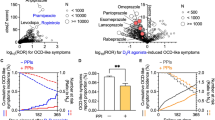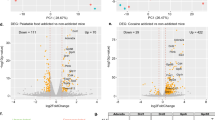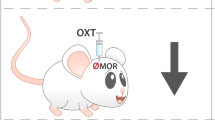Abstract
Peptides of the endozepine family, including diazepam-binding inhibitor, the triakontatetraneuropeptide, and the octadecaneuropeptide (ODN), act through three types of receptors, that is, central-type benzodiazepine receptors (CBR), peripheral-type (mitochondrial) benzodiazepine receptors (PBR) and a metabotropic receptor positively coupled to phospholipase C via a pertussis toxin-sensitive G protein. We have previously reported that ODN exerts a potent anorexigenic effect in rat and we have found that the action of ODN is not affected by the mixed CBR/PBR agonist diazepam. In the present report, we have tested the possible involvement of the metabotropic receptor in the anorexigenic activity of ODN. Intracerebroventricular administration of the C-terminal octapeptide (OP) and its head-to-tail cyclic analog cyclo1–8OP (cOP) at a dose of 100 ng mimicked the inhibitory effect of ODN on food intake in food-deprived mice. The specific CBR antagonist flumazenil and the PBR antagonist PK11195 did not prevent the effect of ODN, OP, and cOP on food consumption. In contrast, the selective metabotropic endozepine receptor antagonist cyclo1–8[DLeu5]OP (100–1000 ng; cDLOP) suppressed the anorexigenic effect of ODN, OP, and cOP. At the highest concentration tested (1000 ng), cDLOP provoked by itself a significant increase in food intake. Taken together, the present results indicate that the anorexigenic effect of ODN and OP is mediated through activation of the metabotropic receptor recently characterized in astrocytes. The data also suggest that endogenous ODN, acting via this receptor, exerts an inhibitory tone on feeding behavior.
Similar content being viewed by others
Log in or create a free account to read this content
Gain free access to this article, as well as selected content from this journal and more on nature.com
or
References
Alho H, Costa E, Ferrero P, Fujimoto M, Cosenza-Murphy D, Guidotti A (1985). Diazepam-binding inhibitor: a neuropeptide located in selected neuronal populations of rat brain. Science 229: 179–182.
Alho H, Fremeau Jr RT, Tiedge H, Wilcox J, Bovolin P, Roberts JL et al (1988). Diazepam binding inhibitor gene expression: location in brain and peripheral tissues of rat. Proc Natl Acad Sci USA 85: 7018–7022.
Berkovich A, McPhie P, Campagnone M, Guidotti A, Hensley P (1990). A natural processing product of rat diazepam binding inhibitor, triakontatetraneuropeptide (diazepam binding inhibitor 17–50) contains an alpha-helix, which allows discrimination between benzodiazepine binding site subtypes. Mol Pharmacol 37: 164–172.
Bonetti EP, Pieri L, Cumin R, Schaffner R, Pieri M, Gamzu ER et al (1982). Benzodiazepine antagonist RO 15–1788: neurological and behavioral effects. Psychopharmacology 78: 8–18.
Bormann J (1991). Electrophysiological characterization of diazepam binding inhibitor (DBI) on GABAA receptors. Neuropharmacology 30: 1387–1389.
Compère V, Li S, Leprince J, Tonon MC, Vaudry H, Pelletier G (2003). Effect of intracerebroventricular administration of the octadecaneuropeptide on the expression of pro-opiomelanocortin, neuropeptide Y and corticotropin-releasing hormone mRNAs in rat hypothalamus. J Neuroendocrinol 15: 197–203.
Compère V, Li S, Leprince J, Tonon MC, Vaudry H, Pelletier G (2004). In vivo action of a new octadecaneuropeptide (ODN) antagonist on gonadotropin-releasing hormone gene expression in the male rat brain. Neuroscience 125: 411–415.
Compère V, Li S, Leprince J, Tonon MC, Vaudry H, Pelletier G (2005). In vivo action of a new octadecaneuropeptide antagonist on neuropeptide Y and corticotropin-releasing hormone mRNA levels in rat. Mol Brain Res 141: 156–160.
Ferrero P, Santi MR, Conti-Tronconi B, Costa E, Guidotti A (1986). Study of an octadecaneuropeptide derived from diazepam binding inhibitor (DBI): biological activity and presence in rat brain. Proc Natl Acad Sci USA 83: 827–831.
Gandolfo P, Louiset E, Patte C, Leprince J, Masmoudi O, Malagon M et al (2001). The triakontatetraneuropeptide TTN increases [Ca2+]i in rat astrocytes through activation of peripheral-type benzodiazepine receptors. Glia 35: 90–100.
Gandolfo P, Patte C, Leprince J, Thoumas JL, Vaudry H, Tonon MC (1997). The stimulatory effect of the octadecaneuropeptide (ODN) on cytosolic Ca2+ in rat astrocytes is not mediated through classical benzodiazepine receptors. Eur J Pharmacol 322: 275–281.
Garcia de Mateos-Verchere J, Leprince J, Tonon MC, Vaudry H, Costentin J (1998a). The octadecaneuropeptide ODN induces anxiety in rodents: possible involvement of a shorter biologically active fragment. Peptides 19: 841–848.
Garcia de Mateos-Verchere J, Leprince J, Tonon MC, Vaudry H, Costentin J (1998b). The octadecaneuropeptide ODN inhibits apomorphine-induced yawning in rats. Eur J Pharmacol 357: 121–126.
Garcia de Mateos-Verchere J, Leprince J, Tonon MC, Vaudry H, Costentin J (1999). Reduction of pentylenetetrazol-induced convulsions by the octadecaneuropeptide ODN. Peptides 20: 1431–1436.
Garcia de Mateos-Verchere J, Leprince J, Tonon MC, Vaudry H, Costentin J (2001). The octadecaneuropeptide (diazepam-binding inhibitor (33–50)) exerts potent anorexigenic effects in rodents. Eur J Pharmacol 414: 225–231.
Guidotti A, Alho H, Berkovich A, Cox DH, Ferrarese C, Slobodyansky E et al (1989). DBI processing: allosteric modulation at different GABA/benzodiazepine receptor subtypes. In: Barnard EA, Costa E (eds). Allosteric Modulation of Amino Acid Receptors: Therapeutic Implications. Raven Press, Ltd: New York. pp 109–123.
Guidotti A, Forchetti CM, Corda MG, Konkel D, Bennett CD, Costa E (1983). Isolation, characterization and purification to homogeneity of an endogenous polypeptide with agonistic action on benzodiazepine receptors. Proc Natl Acad Sci USA 80: 3531–3535.
Haley TJ, McCormick WG (1957). Pharmacological effects produced by intracerebral injection of drugs in the conscious mouse. Br J Pharmacol 12: 12–15.
Le Fur G, Guilloux F, Rufat P, Uzan A, Renault C, Dubroeucq MC et al (1983). Peripheral benzodiazepine binding sites: effects of PK11195, 1-(2-chloro-phenyl)-N-(1-methylpropyl)-3-isoquinolinecarboxamide. II. In vivo studies. Life Sci 32: 1849–1856.
Leprince J, Gandolfo P, Thoumas JL, Patte C, Fauchère JL, Vaudry H et al (1998). Structure-activity relationships of a series of analogues of the octadecaneuropeptide ODN on calcium mobilization in rat astrocytes. J Med Chem 41: 4433–4438.
Leprince J, Oulyadi H, Vaudry D, Masmoudi O, Gandolfo P, Patte C et al (2001). Synthesis, conformational analysis and biological activity of cyclic analogs of the octadecaneuropeptide ODN. Eur J Biochem 268: 6045–6057.
Louiset E, Vaudry H, Cazin L (1993). Allosteric modulation of the GABA-induced chloride current in frog melanotrophs. Ann NY Acad Sci 680: 564–566.
Malagon M, Vaudry H, Van Strien F, Pelletier G, Gracia-Navarro F, Tonon MC (1993). Ontogeny of diazepam-binding inhibitor-related peptides (endozepines) in the rat brain. Neuroscience 57: 777–786.
Patte C, Vaudry H, Desrues L, Gandolfo P, Strijdveen I, Lamacz M et al (1995). The endozepine ODN stimulates polyphosphoinositide metabolism in rat astrocytes. FEBS Lett 362: 106–110.
Slobodyansky E, Berkovich A, Bovolin P, Wambebe C (1990). The endogenous allosteric modulation of GABAA receptor subtypes: a role for the neuronal posttranslational processing products of rat brain DBI. In: Biggio G, Costa E (eds). GABA and Benzodiazepine Receptor Subtypes. Raven Press: New York. pp 51–61.
Slobodyansky E, Guidotti A, Wambebe C, Berkovich A, Costa E (1989). Isolation and characterization of a rat brain triakontatetraneuropeptide, a posttranslational product of diazepam binding inhibitor: specific action at the RO 5–4864 recognition site. J Neurochem 53: 1276–1284.
Tong Y, Toranzo D, Pelletier G (1991). Localization of diazepam-binding inhibitor (DBI) mRNA in the rat brain by high resolution in situ hybridisation. Neuropeptides 20: 33–40.
Tonon MC, Adjeroud S, Lamacz M, Louiset E, Danger JM, Desrues L et al (1989). Central-type benzodiazepines and the octadecaneuropeptide modulate the effects of GABA on the release of alpha-melanocyte-stimulating hormone from frog neurointermediate lobe in vitro. Neuroscience 31: 485–493.
Tonon MC, Désy L, Nicolas P, Vaudry H, Pelletier G (1990). Immunocytochemical localization of the endogenous benzodiazepine ligand octadecaneuropeptide (ODN) in the rat brain. Neuropeptides 15: 17–24.
Tonon MC, Leprince J, Gandolfo P, Compère V, Pelletier G, Malagon M et al (2006). Endozepines. In: Kastin AJ (ed). Handbook of Biologically Active Peptides. Elsevier, Chapter 10, pp 813–819.
Yanase H, Shimizu H, Yamada K, Iwanaga T (2002). Cellular localization of the diazepam binding inhibitor in glia cells with special reference to its coexistence with brain-type fatty acid binding protein. Arch Histol Cytol 65: 27–36.
Acknowledgements
This work was supported by grants from CNRS (FRE 2735), Inserm (U413), the Regional Platform for Cell Imaging, the European Institute for Peptide Research (IFRMP 23), and the Conseil Régional de Haute-Normandie.
Author information
Authors and Affiliations
Corresponding author
Rights and permissions
About this article
Cite this article
do Rego, JC., Orta, MH., Leprince, J. et al. Pharmacological Characterization of the Receptor Mediating the Anorexigenic Action of the Octadecaneuropeptide: Evidence for an Endozepinergic Tone Regulating Food Intake. Neuropsychopharmacol 32, 1641–1648 (2007). https://doi.org/10.1038/sj.npp.1301280
Received:
Revised:
Accepted:
Published:
Issue date:
DOI: https://doi.org/10.1038/sj.npp.1301280
Keywords
This article is cited by
-
Neuroprotective and Anti-inflammatory Effects of Rubiscolin-6 Analogs with Proline Surrogates in Position 2
Neurochemical Research (2023)
-
Glial Endozepines Reverse High-Fat Diet-Induced Obesity by Enhancing Hypothalamic Response to Peripheral Leptin
Molecular Neurobiology (2020)
-
Metabolic and psychiatric effects of acyl coenzyme A binding protein (ACBP)/diazepam binding inhibitor (DBI)
Cell Death & Disease (2020)
-
Brain Glucose-Sensing Mechanism and Energy Homeostasis
Molecular Neurobiology (2019)
-
Endogenous Expression of ODN-Related Peptides in Astrocytes Contributes to Cell Protection Against Oxidative Stress: Astrocyte-Neuron Crosstalk Relevance for Neuronal Survival
Molecular Neurobiology (2018)



